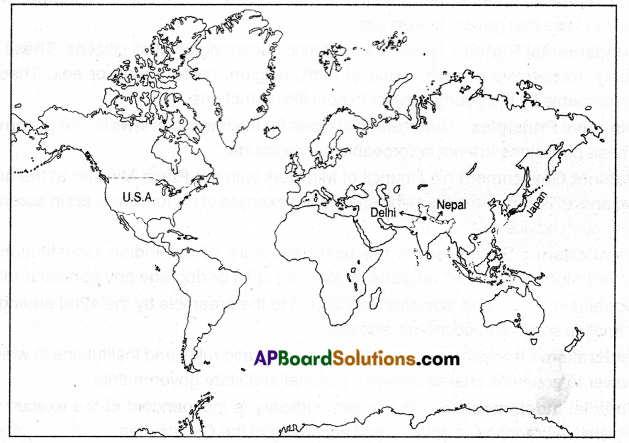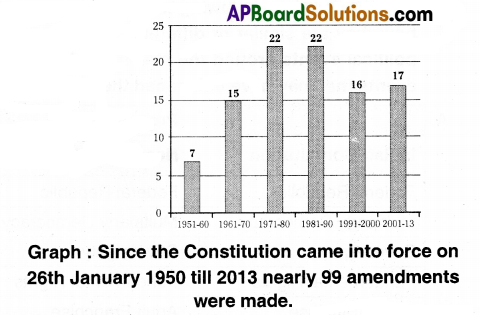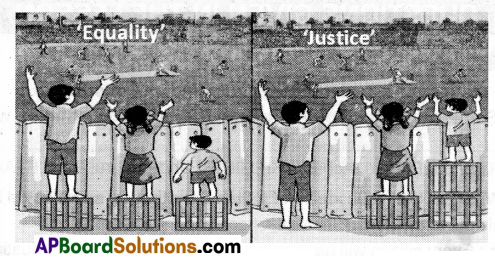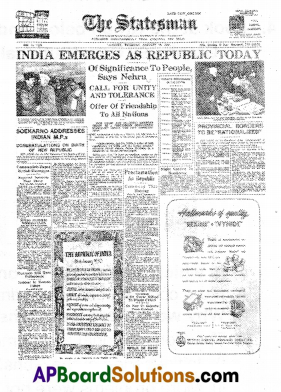Telangana SCERT 10th Class Social Guide Pdf Download Telangana 15th Lesson The Making of Independent India’s Constitution Textbook Questions and Answers.
TS 10th Class Social 15th Lesson Questions and Answers – The Making of Independent India’s Constitution
Question 1.
Find the odd one out.
a) Indian Constitution adopts from experiences of freedom struggle.
b) Indian Constitution adopts from already existing Constitutions.
c) Indian Constitution has remained the same since Its drafting.
d) Indian Constitution provides principles and provisions for ruling the country.
Answer:
c) Indian Constitution has remained the same since its drafting.
Question 2.
Correct the false statements:
a) There was unanimity of opinion on all provisions during CA debates.
b) The makers of Constitution represented only certain regions of the country.
c) Constitution provides certain provisions to amend articles In it.
d) Supreme Court of dla has said that basic features of Constitution may also be amended.
Answer:
a) There were differences of opinions on many provisions during CA debates.
b) The makers of Constitution represented all regions of the country.
c) The statement is correct.
d) Supreme Court of India has said that basic features of Constitution cannot be amended.
Question 3.
Describe the unitary and federal principles of Indian government as discussed in the CA debates.
Answer:
Two principal forms of the Constitution are known to history one is called Unitary and the other Federal. The two essential characteristics of a Unitary Constitution are:
- the supremacy of the Central Polity [the word polity means system of government or political organization] and
- the absence of subsidiary Sovereign polities.
Contrariwise, a Federal Constitution is marked:
- by me the existence of a Central polity and subsidiary policies side by side, and
- by each being sovereign in the field assigned to it. In other words, Federation means the establishment of a Dual Polity [dual system of government central and state]. The Draft Constitution is.
Federal Constitution in as much as it establishes what may be called a Dual Polity. This Dual Polity under the proposed Constitution will consist of the Union at the Centre and the States at the periphery each endowed with sovereign powers to be exercised in the field assigned to them respectively by the Constitution.
Question 4.
How does the Constitution reflect the political events of the time? Draw from previous chapters on freedom struggle.
Answer:
The Constitution reflects the political events of the time.
e.g.:
Self-Government and Equality: A reference to the history of British rule and Indian Independence struggle provides basic idea of self-governance that emerged into a people’s participative democracy.
Federalism: Genesis of dee of federalism in India was first traced in Simon Commission 1927. The representatives of princely states declared the First Round table Conference (1930-32) that they would cm an All India federation with a sell-governing British Inca. This preferred creation of All India Federation.
Fundamental Rights: The inclusion ¡ri Constitution of a distinct part guaranteeing Fundamental Rights can be traced to the forces that operated in the struggle for independence during British rule.
Sovereignty: The British colonial rule made the Constitution framers to add the Sovereignty in our Constitution.
Socialism: Despite all social, economic, and political inequality present and inherent in Indian traditional society, there were many political struggles. So our Constitution started a crusade against that.
![]()
Question 5.
What difference would it have made to the making of our Constitution if the Assembly had been elected through universal adult franchise?
Answer:
It would be more democratic if the Constituent Assembly had been elected through universal adult franchise.
Question 6.
Write a short note on basic principles of Indian Constitution.
Answer:
The Indian Constitution has 8 basic principles
- Popular Sovereignty
- Fundamental Rights
- Directive Principles
- Cabinet Government
- Secularism
- Socialism
- Federalism
- Judicial Independence
1) Popular Sovereignty: India is externally free from the control of any foreign power and internally, It has a free government which is directly elected by the people and makes laws that govern the people.
2) Fundamental Rights: These are the basic human rights of all citizens. These rights apply irrespective of race, place of birth, religion, caste, creed, or sex These are enforceable by the courty subject to specific restrictions.
3) Directive Principles: These are guidelines for the framing of laws by the government. These provisions are not enforceable by the courts.
4) CabInet Government: A Council of Ministers with the Prime Minister at the head to aid and advise the President who shall, in the exercise of his functions, act in accordance with such advice.
5) Secularism: Secularism is the basic structure of the Indian Constitution. The government respects all religions. It does not uplift or degrade any particular religion.
6) Socialism: The word ‘socialist was added to the preamble by the 42nd amendment. it implies social and economic equality.
7) Federalism: It is a system based upon democratic rules and institutions In which the power to govern Is shared between national and state governments.
8) Judicial Independence: The Indian Judiciary is independent of the executive and legislative branches of government according to the Constitution.
Question 7.
How has the Constitution defined and changed political Institutions In the country?
Answer:
The Constitution of India defines all aspects cl the Indian political system including its basic objectives.
- the territories that India will comprise.
- citizenship
- fundamental rights
- directive principles of state policy and fundamental duties
- the structure and functioning of governments at union, state and local levels, and
- several other aspects of the political system.
It defines India as a sovereign, democratic, socialist, and secular republic. It has provisions for bringing about social change and defining the relationship between individual citizens and the state.
Question 8.
While Constitution provides basic principles It Is the engagement of people with the system that brings In social change. Do you agree with this statement, give reasons?
Answer:
Yes, I agree with the statement
Reasons:
We, the people of India. adopted a Constitution which is sovereign, democratic, secular and socialst In nature, committed to the goats of justice, equality, liberty, and fraternity.
Freedom and self-realization for Individual justice in the arrangement of the society, and participation in the decision-making, are all necessary values for constructing a society. But It Is necessary to see that they do not become mere forms, devoid of content of collective effort.
Question 9.
Locate the following on the map of the world.
a) Nepal
b) Japan
c) Delhi
d) USA
Answer:

Question 10.
Observe the Bar graph given in page 226 and answer the following questions.
i) In which year the most number of constitutional amendments took place?
ii) How many more number of amendments took place in the decade 1971-80 when compared to 1961-70?
Answer:
i) The most number cl constitutional amendments took place during 1971-80 and 1981-90,
ii) 7 more amendments took place in the decade 1971-80 when compared to 1961-70,

![]()
Question 11.
Prepare a poster on the implementation of equity In your school.
Answer:
Equality In Our School
We study together
We play together
We live together
A good quality
We all have is equality
We are all equal in our school. No discrimination are there in our school. Our teachers give us equal importance. Our registers do not maintain caste columns. Our applications contain the name of our father and mother columns. Boys and girls are treated in the same way. We play all the games and sports. We feel no difference at all.
TS 10th Class Social 15th Lesson The Making of Independent India’s Constitution Intext Questions
Page No. 212
Question 1.
Complete the following tasks regarding the Indian Constitution.
Task (1): Some significant contributors to the Indian constitution were:
Answer:
……………….,…………………..,……………….,………………….
Answer:
Sri Babu Rajendra Prasad, Acharya Kripalani, Pandit Nehru, Dr. BR. Ambedkar.
Task (2): What are the basic Ideals of Indian Constitution as reflected in its Preamble?
Answer:
Basic ideals of Indian Constitution as reflected in the Preamble:
1) Justice: Every citizen wilt have social, economical, and political justice.
2) Liberty: Every citizen will have the liberty of thought, expression, belief, faith, and worship.
3) Equality: Every citizen will be provided with the equality of status and of opportunity.
4) Fraternity: Citizens of India have been assured about the dignity of the individual and unity, integrity of the nation.
Task 3): Read th. following two preambles along with the Indian Preamble and see how they are similar or different. Remember that each Constitution also reflects political events around the making of their nations. Try to relate to the political events that may have influenced the thought that went Into the Constitution.
Answer:
| Preambles of | ||
| Indian Constitution | Nepal Constitution | Japan Constitution |
| Federal Republic | Federal Republic | Peaceful co-operation |
| Multiparty Democracy | Multiparty Democracy | Blessings of liberty |
| Sovereignty | Sovereignty | Sovereignty |
| Fundamental Rights | Fundamental Rights | Trusting in the justice |
| Adult Franchise | Adult Franchise | Faith of the peace-loving people |
| Periodic Elections | Periodic Elections | Banishment of Tyranny and Slavery |
| Independent Judiciary Integrity | Independent Judiciary Integrity | |
The political events that may have influenced the thought that went into the Constitution:
India: The differences in traditional India and disparities in colonial India and political movements shaped the Indian Constitution.
Nepal: The political movements against Monarchy formed the Nepal Constitution.
Japan: The results of World War. Il shaped the Japanese Constitution so.
Page No. 216
Question 2.
Discuss the idea of equality and justice as shown ¡n this picture.

Answer:
Irrespective of advantage gained by birth, religion, gender, and physique, treating and making everyone equal is the basic ideal of equality and justice.
Here in the first picture, the small boy is deprived of enjoyment because he is short. By enabling him, giving support, to stand with equal height, he is given an equal opportunity with others. This shows all can enjoy equal status and opportunities In a welfare state a main feature of a democratic state. For this Indian, Constitution provides reservations to some people lo bring i. them economically arid socially along with other equally in the society.
Page No. 217 & 218
Question 3.
The Constitution of India begins with the statement, “We the people of India…”. Do you think this claim to represent all the people of India was justified?
Answer:
Yes,l think so.
I think this claim to represent all the people of India was justified.
Question 4.
Do you think all the people in India can participate in the formulation of Constitution for the entire country? Was It important for all people to participate actively in this process or could It have been left to some wise people?
Answer:
I think all people of India cannot participate directly In the formulation of Constitution for the entire country.
There is one saying that ‘Too many cooks spoil the food. Likewise, it was not important for all people to participate actively in the process. It could have been left to some wise people. But the wise people should be elected by the citizens of the whole nation.
Question 5.
If a Constitution for the entire school has to be drafted, who all should be Involved in It and how?
Answer:
If a Constitution for the entire school had to be drafted, the headmaster, teaching and non-teaching staff, and the SPL, CPLs should be involved in it. The students should reveal their ideas by discussions. Those ideas should be finalized in a general meeting. Then the teachers should prepare the draft constitution. Later it also
should be discussed point-wise. After that, the original constitution should be written. Then It should be signed by the Headmaster/mistress. Later it will come into existence.
![]()
Question 6.
Fill In the blanks.
a) Drafting Committee was appointed roughly …………………… days after the Independence.
Answer:
fourteen,
b) The Assembly first appointed special committees on specific issues like, ………………. , …………………… ,and …………………… .
Answer:
Union Powers, Union Constitution, the Provision Constitution.
c) The reports of these committees were discussed by the ………………….. and key decisions
were taken by It.
Answer:
Constituent Assembly,
d) The …………………….. Committee headed by Dr. Arthedkar had to incorporate these decisions.
Answer:
Drafting,
e) The Draft also drew upon provisions of the …………….. passed by the British Government.
Answer:
Government of Inca Act, 1935,
f) It was then made available to public for months so that they could evaluate it and give their suggestions on it.
Answer:
eight,
g) in the Draft Con situation there were ……………….. Articles and ……………….. Schedules.
Answer:
395, 8.
Page No. 219
Question 7.
Fill in the blanks.
a) The powers given to Incan President are more similar to of ……………………… than …………………………… of ………………………. .
Answer:
King; Britain; President; the USA
b) Constituent Assembly visualized that the Indian President follows the advice of ……………. .
Answer:
Ministers
Question 8.
What do you think was the difference between the position of the British King and the President of india?
Answer:
The difference between the position of the President of India and the British King: Under the Draft Constitution me President occupies the same position as the King under the English Constitution. He is the head of the state but not of the Executive. He represents the nation but does not rule the nation. He Is the symbol of the nation. His place in the administration is that of a ceremonial device or a seal by which the nation’s decisions are made known.
Page No. 220
Question 9.
Under federal polity, there are more than one government and in the Indian context we have them at ………………….. and …………………. levels. You belong to ……………….. state while you belong to ………………….. nation.
Answer:
Central; State: Telangana; Indian.
Question 10.
Which type of Constitution gives more powers to the governments at the Centre?
Answer:
A Unitary type of Constitution gives more powers to The governments at the Centre.
Question 11.
Which type of Constitution gives definite powers to both Central and State governments?
Answer:
A Federal type of Constitution gives definite powers to both Central and State Governments.
Question 12.
In what ways are Indian states not “administrative units or agencies of the Union Government”?
Answer:
The dual polity under the proposed Constitution will consist of the Union at the center and the States at the periphery each endowed with sovereign powers to be exercised Ii the field assigned to them respectively by the Constitution. Thus, the Indian Constitution proposed in the Draft Constitution is not a league of states nor are the states’ administrative units or agencies of the Union government.
![]()
Question 13.
Why do you think did the framers of the Indian Constitution reject the idea of dual citizenship (of India and of the state)?
Answer:
To protect the unity and integrity of the nation, the framers of the Indian Constitution rejected the idea of dual citizenship.
Page No. 222
Question 14.
Can you point out the main differences between Indian federalism and American federalism?
Answer:
| Indian Federalism | American Federalism |
| 1) Single citizenship. | 1) Dual citizenship |
| 2) Single judiciary | 2) Dual judiciary |
| 3) Uniformity in fundamental, civil, and criminal laws. | 3) A duality of legal codes. |
| 4) A common All India Civil Service to main important posts. | 4) A duality of services. |
| 5) No matter of difficulty for a citizen who moved from state to state. | 5) Difficult for a citizen who moved from state to state. |
| 6) India has a parliamentary form of government. | 6) America has a presidential form of government |
| 7) In India the Loksabilla (lower house) is more powerful. | 7) In America the House of Senate (Upper house) Is more powerful. |
| 8) Indian constitution s a rigid arid flexible. | 8) American constitution is a only rigid constitution. |
| 9) ln Indian president is nominal head. | 9) In America president has supreme power. |
Question 15.
Does the Indian Constitution allow the states to have their own civil servants (officers)?
Answer:
No, the Indian Constitution does not allow this. The central government appoints them through UPSC.
Question 16.
Are all officials of a state from the state’s civil services?
Answer:
No, all officials are not of a state from the states civil services.
Question 17.
In America. the judiciary of the Central Government and the judiciary of the states are distinct and separate. In India, we have a judiciary in the center and the states Explain.
Answer:
- In America, the judiciary of the central government and that of stales are distinct and separate.
- Whereas we have a single judiciary in our country.
- Our judiciary is integrated which is formed with the Supreme Court, all High Courts, and other courts.
- We have one jurisdiction and provïding remedies in all cases under civil. criminal and constitutional laws.
Page No.223
Question 18.
How were the ideas of Seth and Draft Committee similar or different?
Answer:
The ideas of D.S. Seth and Draft Committee were similar. Both favoured the decentralization of powers.
Question 19.
Find out what form of autonomy la now being made available to villages after the 73rd amendment of the Constitution.
Answer:
Form of autonomy is now been made available to villages after the 73,d amendment of the Constitution:
Article 40 of the Constitution, which enshrines one of the Directive Principles of State Policy, lays down that the state shall take steps to organize village panchayats and endow them with such powers and authority as may be necessary to enable them to function as units of self-government.
Under this, the villages enjoy autonomy in the following Issues:
- Grama Sabha
- Direct elections.
- Reservation of seats.
- Holding elections.
- Constitution of Panchayats, etc.
Page No. 224
Question 20.
What are the differences of opinion that are being raised le the above debate?
Answer:
The differences of opinion are as follows:
- Definition of untouchability.
- Meaning of untouchability.
Question 21.
If you were given the choice to participate In the debate, what solution would you suggest?
Answer:
I would support the ideas of Mr. Ohirendra Nath Dalla.
Question 22.
Do you think it was a good idea to leave the term undefined In the Constitution? Give reasons for your argument.
Answer:
I think the word ‘untouchability’ should be removed from the dictionary. The present generation does not know the word or action of untouchability. So it should be ignored.
![]()
Question 23.
Do you agree with the view that the Constitution should have put an end to all aspects of the caste system Instead of just ending untouchability? How do you think could It have been done?
Answer:
No. I do not think so. India is built on the pillars of caste system. It is not possible to put an end to that system. Untouchability should be ended through laws The people of the nation should be given awareness In the caste system.
Page No. 225
Question 24.
Newspaper report from 26’ January 1950. What items can you read on this page?
(OR)
Observe the newspaper cutting and answer the following question. What items can you read on this page?
Answer:

- This was the first page of the newspaper of January 26th, 1950.
- Nehru stated that India emerged as a republic.
- Nehru called for unity and tolerance.
- Soekamo congratulated Indian MPs for the birth of new republic.
- The preamble of our Constitution is printed.
- Photo of Nehru who was signing on the cabinet assertedly was also printed.
- Today’s programme in Calcutta was also printed.
Page No. 227
Question 25.
What are the examples and explanations that you can identify with basic features of Indian Constitution?
Answer:
- Fundamental Rights: Keshavanada Bharati Vs Kerala
- Provision for various writs:
The Constitution provides that High Courts and the Supreme Court can issue various writs to safeguard the freedom an individual. eg: Habeas corpus. Mandamus, etc. - Directive Principles of State Policy:
Gram Panchayats.
Uniform civil code.
Free and compulsory education. - Fundamental Duties: The duties of every citizen of Indra.